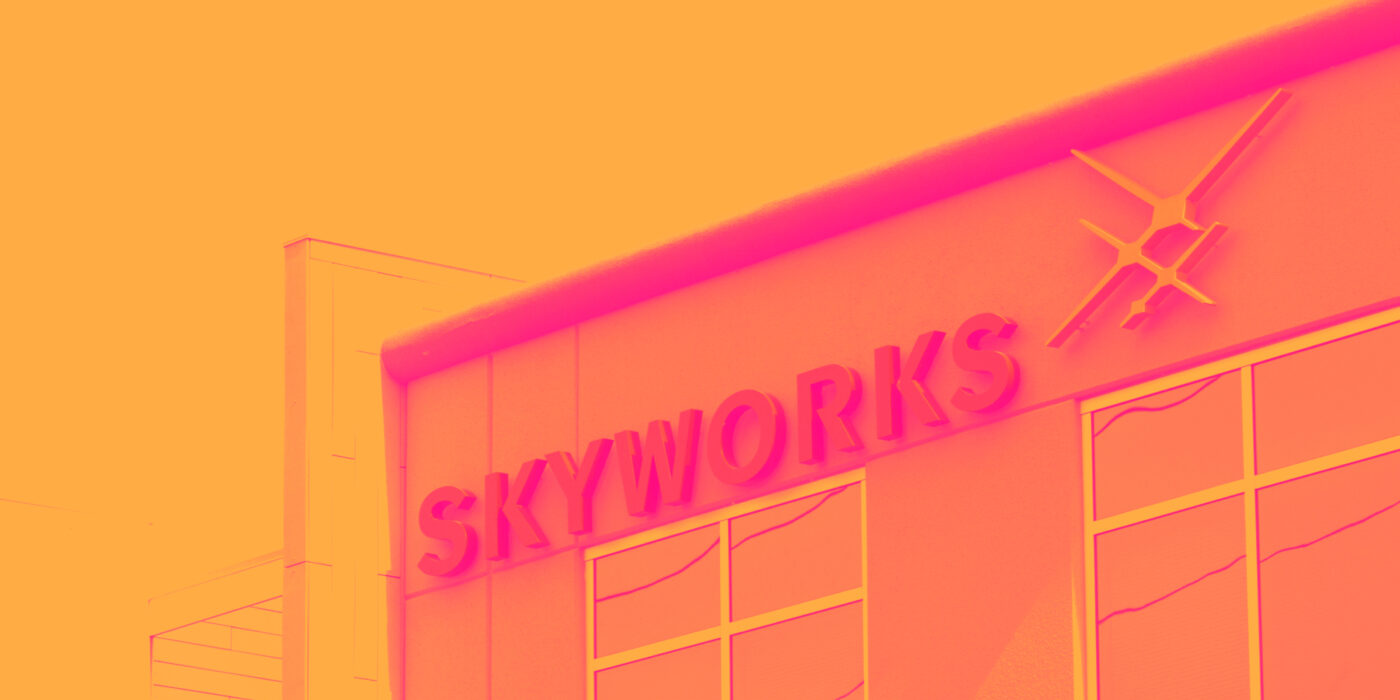Wireless chips maker Skyworks Solutions (NASDAQ: SWKS) reported results in line with analysts' expectations in Q1 CY2024, with revenue down 9.3% year on year to $1.05 billion. On the other hand, next quarter's revenue guidance of $900 million was less impressive, coming in 12.1% below analysts' estimates. It made a non-GAAP profit of $1.55 per share, down from its profit of $2.02 per share in the same quarter last year.
Skyworks Solutions (SWKS) Q1 CY2024 Highlights:
- Revenue: $1.05 billion vs analyst estimates of $1.05 billion (in line)
- EPS (non-GAAP): $1.55 vs analyst estimates of $1.52 (1.7% beat)
- Revenue Guidance for Q2 CY2024 is $900 million at the midpoint, below analyst estimates of $1.02 billion
- Gross Margin (GAAP): 40.2%, down from 45.7% in the same quarter last year
- Inventory Days Outstanding: 122, in line with the previous quarter
- Free Cash Flow of $272.6 million, down 63.8% from the previous quarter
- Market Capitalization: $17.31 billion
Result of a merger of Alpha Industries and the wireless communications division of Conexant, Skyworks Solutions (NASDAQ: SWKS) is a designer and manufacturer of chips used in smartphones, autos, and industrial applications to amplify, filter, and process wireless signals.
Skyworks is an analog chip maker whose chips are used in radio frequency (RF) functions, essentially the chips that decode wireless signals. The most obvious use case is in mobile phones, and this is its biggest business, supplying Apple with RF chips for its iPhones accounts for a significant part of Skyworks revenues.
But Skyworks chips are also used for any connected device that processes wireless signals – such as the array of sensors that make up the Internet of Things and growing uses in factories and autos.
In 2021, Skyworks acquired Silicon Lab’s infrastructure and automotive business, to increase its exposure to autos and industrials. As the world’s wireless networks evolve from 3G to 4G to 5G, a wider variety of wireless spectrum and frequency bands come into play, which translates into a rising amount of RF content in smartphones, cars, and any connected device, a long term secular tailwind RF producers stand to benefit from.
Skyworks’s peers and competitors include Broadcom (NASDAQ:AVGO), Cirrus Logic (NASDAQ:CRUS), MACOM Technology (NASDAQ:MTSI), Qorvo (NASDAQ:QRVO), Qualcomm (NASDAQ:QCOM), and Texas Instruments (NASDAQ:TXN).
Analog Semiconductors
Longer manufacturing duration allows analog chip makers to generate greater efficiencies, leading to structurally higher gross margins than their fabless digital peers. The downside of vertical integration is that cyclicality can be more pronounced for analog chipmakers, as capacity utilization upsides work in reverse during down periods.
Sales Growth
Skyworks Solutions's revenue growth over the last three years has been unimpressive, averaging 4.1% annually. This quarter, its revenue declined from $1.15 billion in the same quarter last year to $1.05 billion. Semiconductors are a cyclical industry, and long-term investors should be prepared for periods of high growth followed by periods of revenue contractions (which can sometimes offer opportune times to buy).
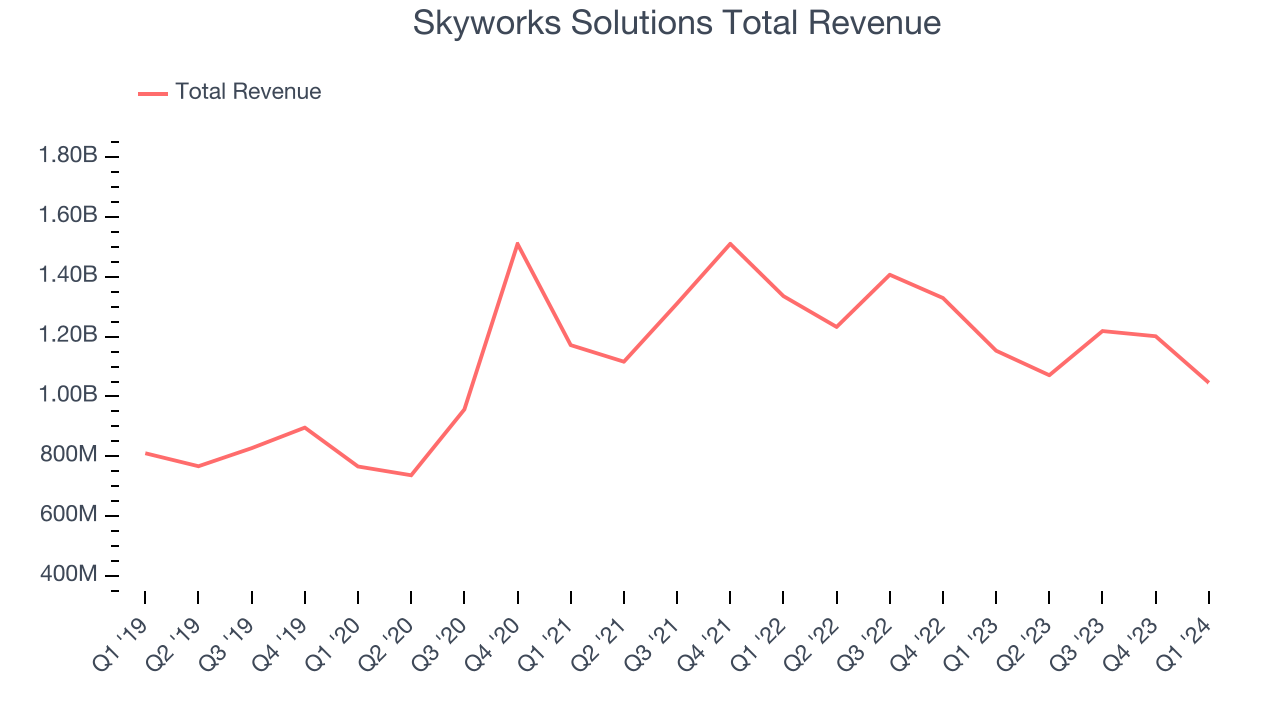
Skyworks Solutions had a difficult quarter as revenue dropped 9.3% year on year, missing analysts' estimates by 0%. This could mean that the current downcycle is deepening.
Skyworks Solutions may be headed for an upturn. Although the company is guiding for a year-on-year revenue decline of 16% next quarter, analysts are expecting revenue to grow 0.5% over the next 12 months.
Product Demand & Outstanding Inventory
Days Inventory Outstanding (DIO) is an important metric for chipmakers, as it reflects a business' capital intensity and the cyclical nature of semiconductor supply and demand. In a tight supply environment, inventories tend to be stable, allowing chipmakers to exert pricing power. Steadily increasing DIO can be a warning sign that demand is weak, and if inventories continue to rise, the company may have to downsize production.
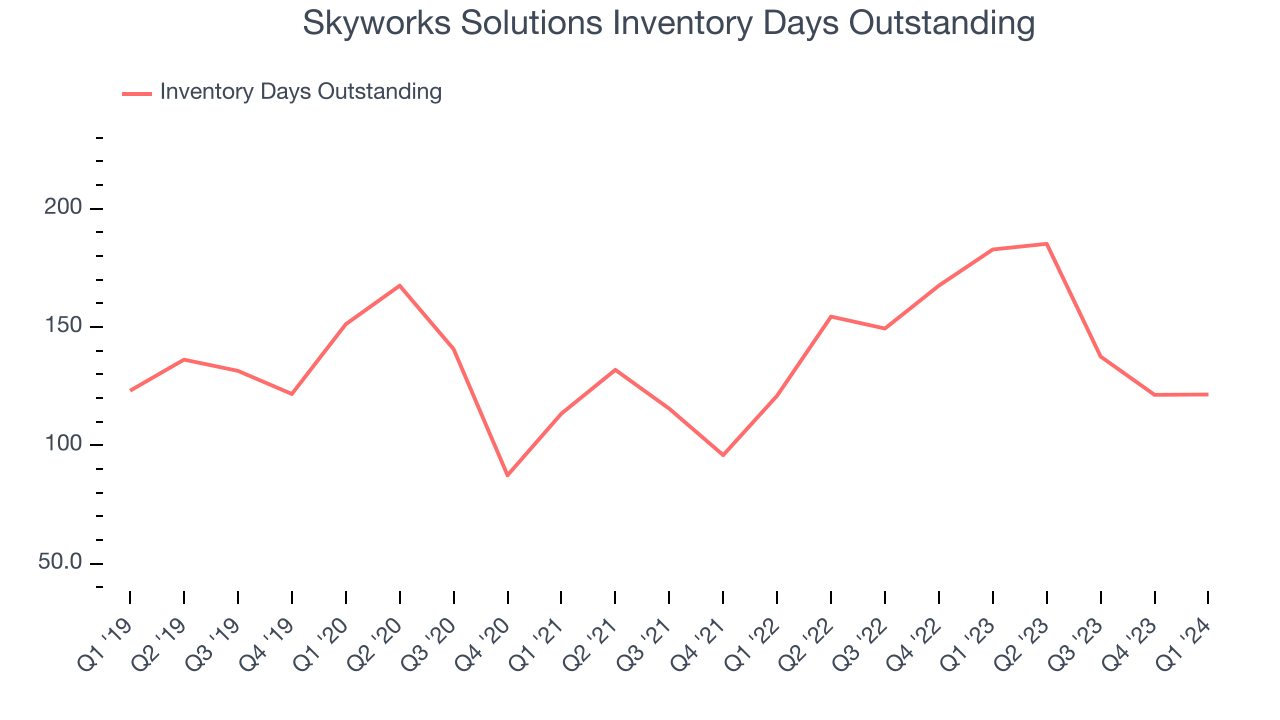
This quarter, Skyworks Solutions's DIO came in at 122, which is 15 days below its five-year average. These numbers show that despite the recent increase, there's no indication of an excessive inventory buildup.
Pricing Power
In the semiconductor industry, a company's gross profit margin is a critical metric to track because it sheds light on its pricing power, complexity of products, and ability to procure raw materials, equipment, and labor. Skyworks Solutions's gross profit margin, which shows how much money the company gets to keep after paying key materials, input, and manufacturing costs, came in at 40.2% in Q1, down 5.6 percentage points year on year.
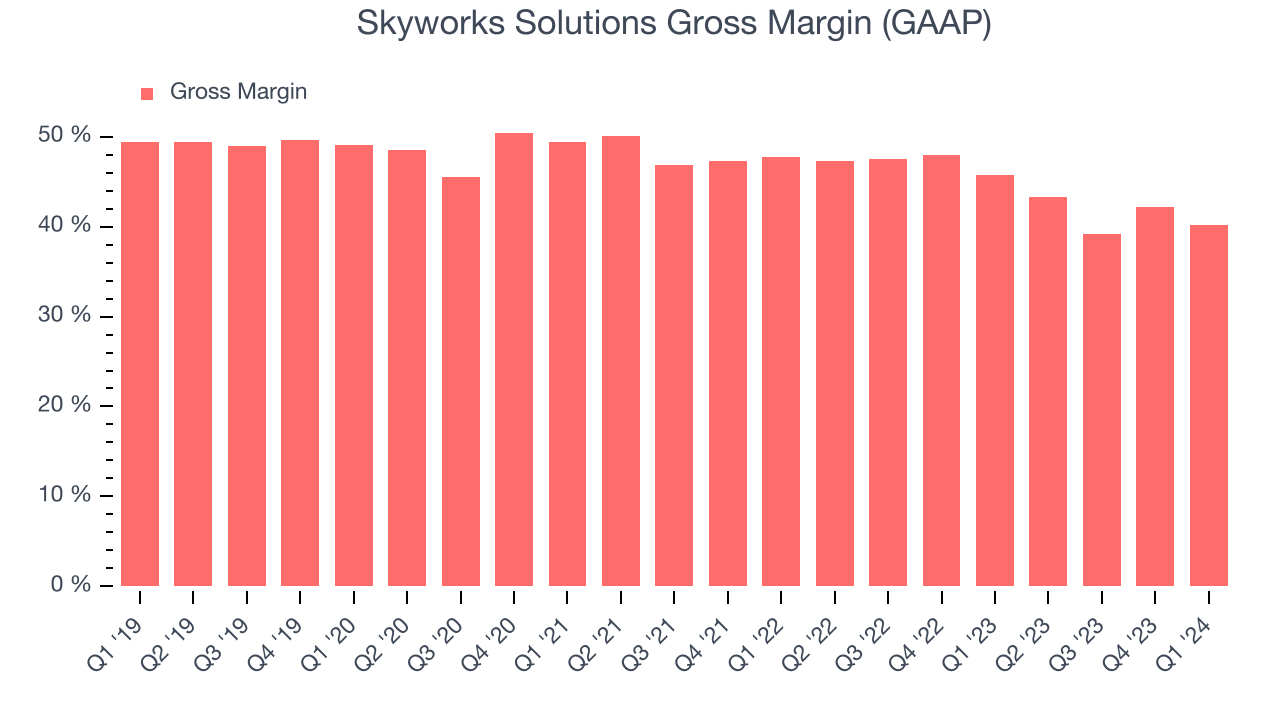
Skyworks Solutions's gross margins have been trending down over the last 12 months, averaging 41.2%. This weakness isn't great as Skyworks Solutions's margins are already far below other semiconductor companies and suggest shrinking pricing power and loose cost controls.
Profitability
Skyworks Solutions reported an operating margin of 26.7% in Q1, down 6.8 percentage points year on year. Operating margins are one of the best measures of profitability because they tell us how much money a company takes home after manufacturing its products, marketing and selling them, and, importantly, keeping them relevant through research and development.
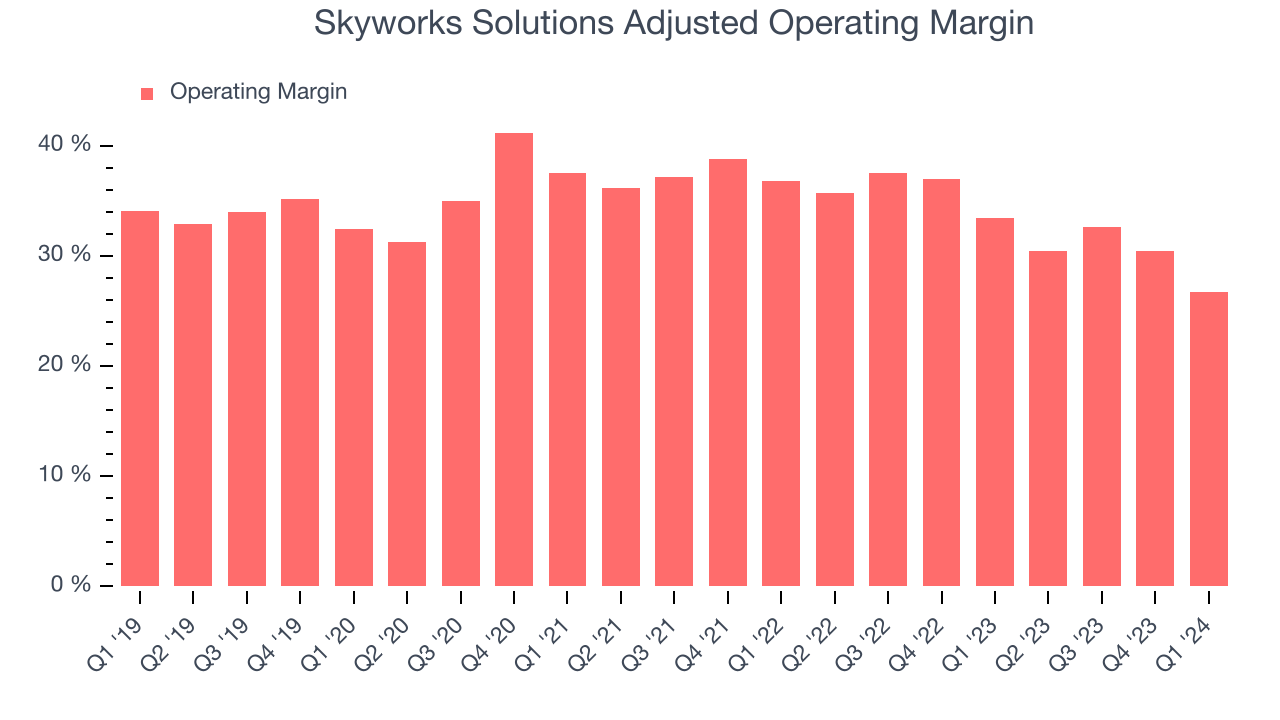
Skyworks Solutions's operating margins have been trending down over the last year, averaging 30.2%. However, the company's profitability is still above average for semiconductor companies, driven by an efficient cost structure.
Earnings, Cash & Competitive Moat
Analysts covering Skyworks Solutions expect earnings per share to be relatively flat over the next 12 months, although estimates will likely change after earnings.
Although earnings are important, we believe cash is king because you can't use accounting profits to pay the bills. Skyworks Solutions's free cash flow came in at $272.6 million in Q1, down 25.6% year on year.
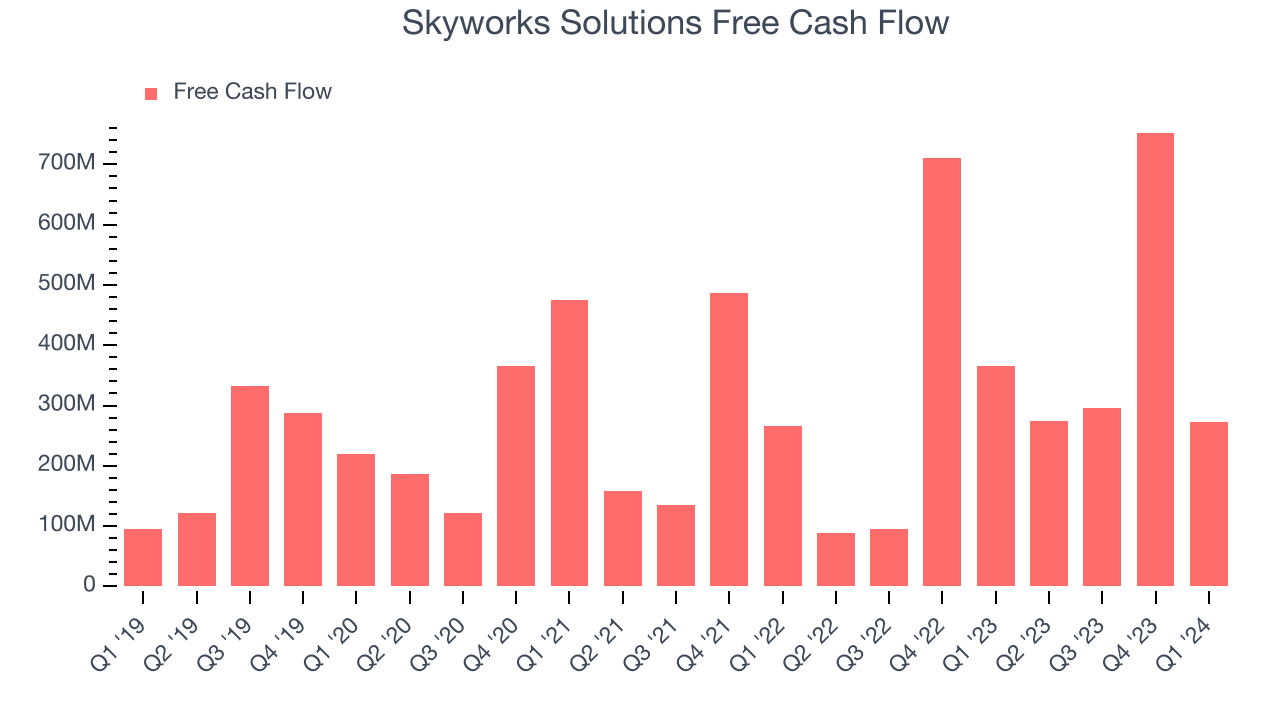
As you can see above, Skyworks Solutions produced $1.60 billion in free cash flow over the last 12 months, an eye-popping 35.2% of revenue. This is a great result; Skyworks Solutions's free cash flow conversion places it among the best semiconductor companies and, if sustainable, puts the company in an advantageous position to invest in new products while remaining resilient during industry downturns.
Return on Invested Capital (ROIC)
EPS and free cash flow tell us whether a company was profitable while growing revenue. But was it capital-efficient? Enter ROIC, a metric showing how much operating profit a company generates relative to how much money the business raised (debt and equity).
Although Skyworks Solutions hasn't been the highest-quality company lately because of its poor top-line performance, it historically did a solid job investing in profitable business initiatives. Its five-year average ROIC was 23.9%, higher than most semiconductor companies.
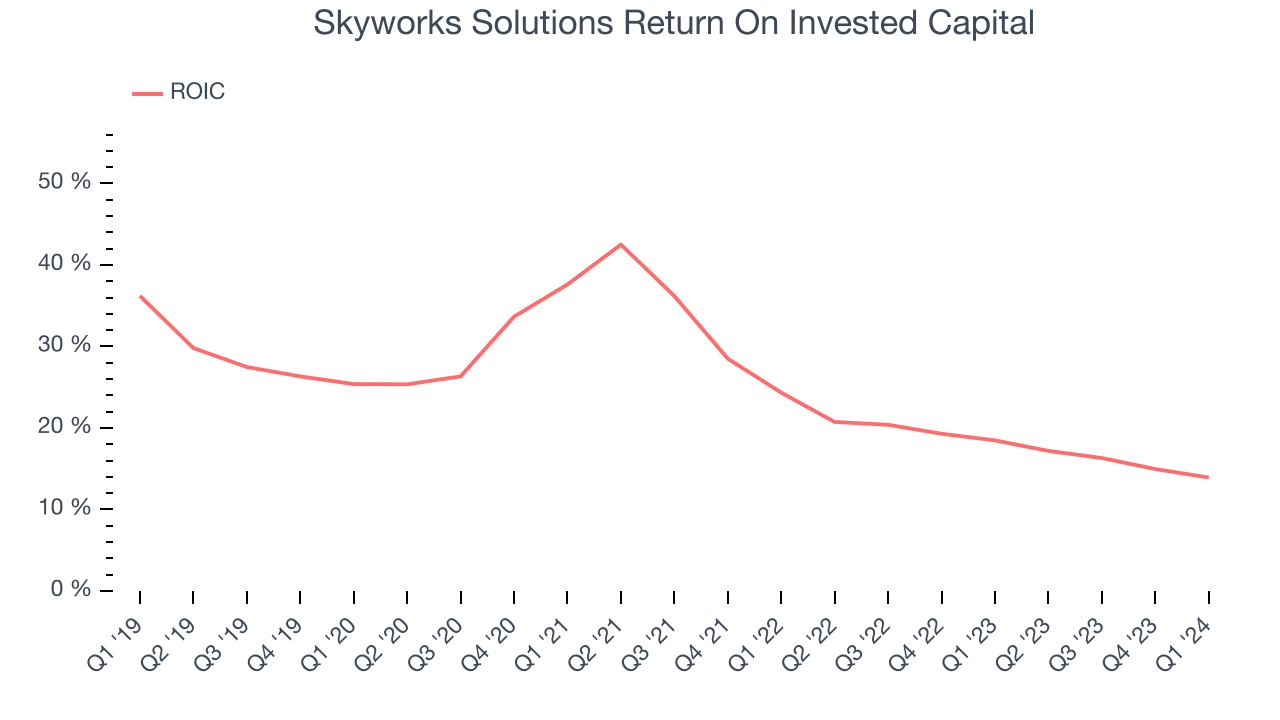
The trend in its ROIC, however, is often what surprises the market and drives the stock price. Unfortunately, Skyworks Solutions's ROIC significantly decreased over the last few years. We like what management has done historically but are concerned its ROIC is declining, perhaps a symptom of waning business opportunities to invest profitably.
Balance Sheet Risk
As long-term investors, the risk we care most about is the permanent loss of capital. This can happen when a company goes bankrupt or raises money from a disadvantaged position and is separate from short-term stock price volatility, which we are much less bothered by.
Skyworks Solutions is a well-capitalized company with $1.22 billion of cash and $993.6 million of debt, meaning it could pay back all its debt tomorrow and still have $227.7 million of cash on its balance sheet. This net cash position gives Skyworks Solutions the freedom to raise more debt, return capital to shareholders, or invest in growth initiatives.
Key Takeaways from Skyworks Solutions's Q1 Results
It was good to see Skyworks Solutions beat analysts' EPS expectations this quarter. On the other hand, its free cash flow missed, and its revenue and EPS guidance for next quarter fell short of analysts' expectations. Management attributes the weaker outlook to an anticipated decline in its mobile business as it clears its excess inventory.
A silver lining was that the company announced a dividend of $0.68 per share, which will be paid on June 11, 2024 to stockholders of record on May 21, 2024.
Overall, this was a tough quarter for Skyworks Solutions. The company is down 6.7% on the results and currently trades at $99.49 per share.
Is Now The Time?
Skyworks Solutions may have had a bad quarter, but investors should also consider its valuation and business qualities when assessing the investment opportunity.
Although Skyworks Solutions is't a bad business, it probably wouldn't be one of our picks. Its revenue growth has been weak over the last three years, and analysts expect growth to deteriorate from here. And while its powerful free cash generation enables it to sustainably invest in growth initiatives while maintaining an ample cash cushion, unfortunately, its gross margins are weaker than its semiconductor peers we look at.
Skyworks Solutions's price-to-earnings ratio based on the next 12 months is 14.5x. In the end, beauty is in the eye of the beholder. While Skyworks Solutions wouldn't be our first pick, if you like the business, the shares are trading at a pretty interesting price right now.
Wall Street analysts covering the company had a one-year price target of $115.74 per share right before these results (compared to the current share price of $99.49).
To get the best start with StockStory check out our most recent Stock picks, and then sign up to our earnings alerts by adding companies to your watchlist here. We typically have the quarterly earnings results analyzed within seconds of the data being released, and especially for the companies reporting pre-market, this often gives investors the chance to react to the results before the market has fully absorbed the information.
